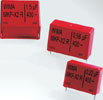Capacitors suppress RF interference
5 August 2009
Passive Components

Corona or partial discharge of metallised plastic film capacitors is regularly caused by ionisation of air pockets in the capacitor winding element. In demanding AC voltage circuits eg, where voltage is supplied via a capacitor power supply (the capacitor is switched in series to the load circuit as a low-loss series impedance) transient over-voltage may exceed the dielectric strength of the air pockets and cause partial discharge that may result in local demetallisation of the film and thus a considerable capacitance reduction.
WIMA MKP-X2 R series capacitors have been specially designed to cover such applications. Due to their internal series connection, they reportedly exhibit one and a half to two times as high corona inception voltage and thus higher rated AC voltage values than comparable components without series connection. They are well suited for applications with stringent requirements to the capacitance stability over time, and also for safety relevant applications like electromagnetic interference suppressor units at the mains input.
The capacitors are available with capacitances of 0,033 μF to 10 μF and a rated voltage of 400 V a.c.
For more information contact Greg Parker, Avnet Kopp, +27 (0)11 809 6100, [email protected], www.avnet.co.za
Further reading:
Vibration-resistant axial capacitors
RS South Africa
Passive Components
TDK Corporation has unveiled the B41699 and B41799 series of ultra-compact aluminium electrolytic capacitors, engineered to withstand operating temperatures of up to 140°C.
Read more...
Capacitors for demanding industrial applications
Passive Components
TDK Corporation has announced its X1 capacitors of the EPCOS B3291xH/J4 series for power line filtering of electromagnetic interferences in demanding automotive and industrial applications with a rated AC voltage of up to 480 V.
Read more...
Wide frequency range inductors
RS South Africa
Passive Components
TDK Corporation has expanded its ADL4524VL series
(4,5 x 2,4 x 2,6 mm – L x W x H) of wire-wound inductors for automotive power-over-coax.
Read more...
Cutting-edge hybrid capacitors
Avnet Silica
Passive Components
Panasonic Industry recently announced the launch of the ZVU Series Hybrid Capacitors, a cutting-edge solution tailored to meet the escalating demands of advanced electronic systems.
Read more...
Low-profile tantalum chip capacitors
Electrocomp
Passive Components
These general-purpose tantalum capacitors from Kyocera AVX are available in multiple case sizes with low profile options.
Read more...
Coupled inductor for high-performance applications
Passive Components
This coil with MnZn core is characterised by its high permeability and extremely low RDC values, which achieves excellent power density and very high efficiency.
Read more...
Power inductors
iCorp Technologies
Passive Components
he HTF-MP series is more suitable for complex multiphase power supply applications in design, effectively meeting the needs of ultra-thin and high-power devices.
Read more...
SMT power inductors
Future Electronics
Passive Components
The Würth Elektronik WE-MXGI SMT power inductors are the latest addition to Würth Elektronik’s moulded power inductor series, engineered for high-frequency power applications.
Read more...
Large capacitance MLCCs at 100 V
RS South Africa
Passive Components
TDK Corporation has expanded its CGA series for automotive multilayer ceramic capacitors to 10 µF at 100 V in 3225 size.
Read more...
Film and mica capacitors
Actum
Passive Components
By utilising various polymer dielectrics plastics, Exxelia film and mica capacitors meet most technical requirements and serve all functions from standard filtering to specialised applications.
Read more...


